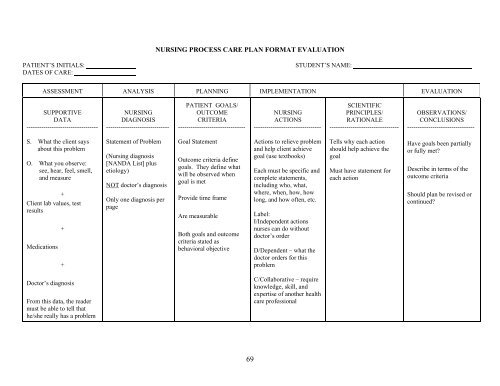Nursing Care Plan Format Explanation
Nursing Care Plan Format Explanation Nursing Care Plan Format Explanation
NURSING PROCESS CARE PLAN FORMAT EVALUATION PATIENT’S INITIALS: STUDENT’S NAME: DATES OF CARE: ASSESSMENT ANALYSIS PLANNING IMPLEMENTATION EVALUATION SUPPORTIVE DATA ---------------------------------- NURSING DIAGNOSIS ------------------------------ PATIENT GOALS/ OUTCOME CRITERIA -------------------------------- NURSING ACTIONS -------------------------------- SCIENTIFIC PRINCIPLES/ RATIONALE --------------------------------- OBSERVATIONS/ CONCLUSIONS -------------------------------- S. What the client says about this problem O. What you observe: see, hear, feel, smell, and measure + Client lab values, test results Medications + + Statement of Problem (Nursing diagnosis [NANDA List] plus etiology) NOT doctor’s diagnosis Only one diagnosis per page Goal Statement Outcome criteria define goals. They define what will be observed when goal is met Provide time frame Are measurable Both goals and outcome criteria stated as behavioral objective Actions to relieve problem and help client achieve goal (use textbooks) Each must be specific and complete statements, including who, what, where, when, how, how long, and how often, etc. Label: I/Independent actions nurses can do without doctor’s order D/Dependent – what the doctor orders for this problem Tells why each action should help achieve the goal Must have statement for each action Have goals been partially or fully met Describe in terms of the outcome criteria Should plan be revised or continued Doctor’s diagnosis From this data, the reader must be able to tell that he/she really has a problem C/Collaborative – require knowledge, skill, and expertise of another health care professional 69
NURSING PROCESS CARE PLAN FORMAT EVALUATION<br />
PATIENT’S INITIALS: STUDENT’S NAME:<br />
DATES OF CARE:<br />
ASSESSMENT ANALYSIS PLANNING IMPLEMENTATION EVALUATION<br />
SUPPORTIVE<br />
DATA<br />
----------------------------------<br />
NURSING<br />
DIAGNOSIS<br />
------------------------------<br />
PATIENT GOALS/<br />
OUTCOME<br />
CRITERIA<br />
--------------------------------<br />
NURSING<br />
ACTIONS<br />
--------------------------------<br />
SCIENTIFIC<br />
PRINCIPLES/<br />
RATIONALE<br />
---------------------------------<br />
OBSERVATIONS/<br />
CONCLUSIONS<br />
--------------------------------<br />
S. What the client says<br />
about this problem<br />
O. What you observe:<br />
see, hear, feel, smell,<br />
and measure<br />
+<br />
Client lab values, test<br />
results<br />
Medications<br />
+<br />
+<br />
Statement of Problem<br />
(<strong>Nursing</strong> diagnosis<br />
[NANDA List] plus<br />
etiology)<br />
NOT doctor’s diagnosis<br />
Only one diagnosis per<br />
page<br />
Goal Statement<br />
Outcome criteria define<br />
goals. They define what<br />
will be observed when<br />
goal is met<br />
Provide time frame<br />
Are measurable<br />
Both goals and outcome<br />
criteria stated as<br />
behavioral objective<br />
Actions to relieve problem<br />
and help client achieve<br />
goal (use textbooks)<br />
Each must be specific and<br />
complete statements,<br />
including who, what,<br />
where, when, how, how<br />
long, and how often, etc.<br />
Label:<br />
I/Independent actions<br />
nurses can do without<br />
doctor’s order<br />
D/Dependent – what the<br />
doctor orders for this<br />
problem<br />
Tells why each action<br />
should help achieve the<br />
goal<br />
Must have statement for<br />
each action<br />
Have goals been partially<br />
or fully met<br />
Describe in terms of the<br />
outcome criteria<br />
Should plan be revised or<br />
continued<br />
Doctor’s diagnosis<br />
From this data, the reader<br />
must be able to tell that<br />
he/she really has a problem<br />
C/Collaborative – require<br />
knowledge, skill, and<br />
expertise of another health<br />
care professional<br />
69
NURSING PROCESS CARE PLAN FORMAT<br />
PATIENT’S INITIALS: STUDENT’S NAME:<br />
DATES OF CARE:<br />
ASSESSMENT ANALYSIS PLANNING IMPLEMENTATION EVALUATION<br />
SUPPORTIVE<br />
DATA<br />
NURSING<br />
DIAGNOSIS<br />
CLIENT GOALS/<br />
OUTCOME<br />
CRITERIA<br />
NURSING<br />
ACTIONS<br />
SCIENTIFIC<br />
PRINCIPLES/<br />
RATIONALE<br />
OBSERVATIONS/<br />
CONCLUSIONS<br />
Subjective:<br />
AI have to keep changing<br />
my pajamas because I can=t<br />
keep them dry.@<br />
Objective:<br />
≅ Residual urine >100 ml<br />
≅ Small frequent voiding<br />
of less than 50 cc<br />
≅ Dribbling (soiled<br />
pajamas and bed linen<br />
≅ Bladder distention<br />
Urinary retention r/t<br />
neurologic impairment<br />
of the bladder secondary<br />
to diabetes<br />
The patient will void<br />
sufficient amounts AEB<br />
STG:<br />
≅ No bladder distention<br />
and no overflow<br />
dribbling during my<br />
shift<br />
≅ Has post void residual<br />
volume of less than 50<br />
ml<br />
LTG:<br />
≅ Demonstrates no s/s of<br />
a UTI by discharge<br />
1. Palpate the bladder q<br />
4Ε. Ind.<br />
2. Implement techniques<br />
that encourage voiding<br />
like positioning<br />
and relaxation. Ind.<br />
3. Catheterize the client<br />
if voiding is repeatedly<br />
unsuccessful or<br />
as ordered. Depend.<br />
4. Instruct the client in<br />
reportable s/s of UTI<br />
(chills, fever, flank<br />
pain, hematuria).<br />
Ind.<br />
1. Palpation allows the<br />
nurse to determine the<br />
presence of bladder<br />
distention.<br />
2. These measures may<br />
initiate the voiding<br />
reflex.<br />
3. Catheterization is used<br />
as a last resort because<br />
of the danger of UTI.<br />
4. Early recognition of<br />
infection facilitates<br />
prompt intervention to<br />
alleviate the problem.<br />
The patient had no bladder<br />
distention; however, had a<br />
PVR or 100 ml on my<br />
shift.<br />
STG partially met. Continue<br />
with goals.<br />
Patient not discharged<br />
during my shift.<br />
Continue with LTG. Goal<br />
not met.<br />
71



